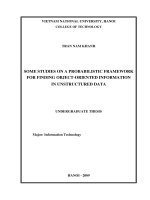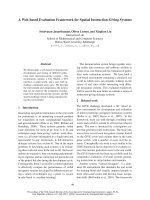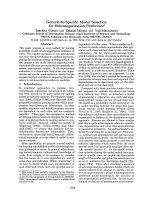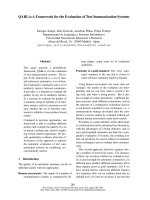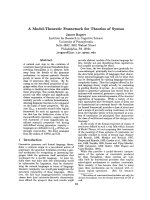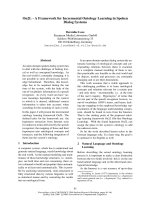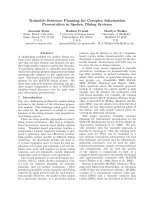agent-based model selection framework for complex adaptive systems
Bạn đang xem bản rút gọn của tài liệu. Xem và tải ngay bản đầy đủ của tài liệu tại đây (3.08 MB, 212 trang )
AGENT-BASED MODEL SELECTION FRAMEWORK
FOR COMPLEX ADAPTIVE SYSTEMS
Tei Laine
Submitted to the faculty of the Graduate School
in partial fulfillment of the requirements
for the degree
Doctor of Philosophy
in Computer Science and Cognitive Science
Indiana University
August 2006
UMI Number: 3229580
3229580
2006
UMI Microform
Copyright
All rights reserved. This microform edition is protected against
unauthorized copying under Title 17, United States Code.
ProQuest Information and Learning Company
300 North Zeeb Road
P.O. Box 1346
Ann Arbor, MI 48106-1346
by ProQuest Information and Learning Company.
Accepted by the Graduate Faculty, Indiana University, in partial ful-
fillment of the requirements of the degree of Doctor of Philosophy.
Doctoral
Committee
Filippo Menczer, Ph.D.
(Principal Advisor)
Michael Gasser, Ph.D.
Jerome Busemeyer, Ph.D.
July 13, 2006 Marco Janssen, Ph.D.
ii
Copyright
c
2006
Tei Laine
ALL RIGHTS RESERVED
iii
Acknowledgements
I want to thank my advisor, Filippo Menczer, and the members of my doctoral
committee, Michael Gasser, Jerome Busemeyer and Marco A. Janssen, for support
and guidance, and first of all for introducing me to research communities that in-
tegrate computing with other disciplines, such as decision making, learning, lan-
guage and evolution, and ecology.
I am grateful to ASLA Fulbright Program for giving m e the opportunity to
pursue my academic interests to fulfillment, together with a possibility to educate
myself both culturally and geographically.
Besides the Fulbright Foundation, my doctoral studies were funded by Com-
puter Science Department and the Biocomplexity grant (NSF SES0083511) for the
Center for the Study of Institutions, Population, and Environmental Change (CIPEC)
at Indiana University. I am grateful for getting an opportunity to work in this truly
multidisciplinary group of scientists led by Elinor Ostrom and Tom Evans, and
share their enthusiasm in solving hard real-world problems. The collaboration al-
lowed me to gain great insight to and appreciate the importance of environmental
modeling. I would also like to take my opportunity to thank CIPEC’s GIS/Remote
Sensing Specialist, Sean Sweeney, and graduate students Shanon Donnelly, Wen-
jie Sun and David Welch for providing me with the data I used in my modeling
studies.
iv
Of course, none of this work would have been possible without the Computer
Science department’s superb system support group. They solved my problems in
a timely manner and provided me with an outstanding environment to work in.
My friend Marion deserves to be acknowledged for her meticulous effort in
proof-reading the text and making useful suggestions to improve its readability.
Thanks also go to students in GLM and NaN groups — Brian, Fulya, Jacob, Josh,
Mark, and Thomas — for attending my practice defense and giving me plenty of
insightful suggestions to improve slides and the oral presentation.
I also like to express my appreciation of Bloomington community and the nu-
merous friends I made here during my stay. The welcoming atmosphere of this
town made it really easy to mingle in and get to know local people in private or
business contexts.
Finally, I thank Tomi, my colleague, long time partner and best friend, not only
for fixing me breakfast every morning and laundering my running gear, but for
endless encouragement, and most importantly, great companionship in our nu-
merous adventures in the US. We have a whole lot more miles to cover!
v
Abstract
Human-initiated land-use and land-cover change is the most significant single
factor behind global climate change. Since climate change affects human, animal
and plant populations alike, and the effects are potentially disastrous and irre-
versible, it is equally important to understand the reasons behind land-use deci-
sions as it is to understand their consequences. Empirical observations and con-
trolled experimentation are not usually feasible methods for studying this change.
Therefore, scientists have resorted to computer modeling, and use other comple-
mentary approaches, such as household surveys and field experiments, to add
depth to their models.
The computer models are not only used in the design and evaluation of envi-
ronmental programs and policies, but they can be used to educate land-owners
about sustainable land management practices. Therefore, it is critical which model
the decision maker trusts. Computer models can generate seemingly plausible out-
comes even if the generating mechanism is quite arbitrary. On the other hand, with
excess complexity the model may become incomprehensible, and proper tweaking
of the parameter values may make it produce any results the decision maker would
like to see. The lack of adequate tools has made it difficult to compare and choose
between alternative models of land-use and land-cover change on a fair basis. Es-
pecially if the candidate models do not share a single dimension, e.g., a functional
vi
form, a criterion for selecting an appropriate model, other than its face value, i.e.,
how well the model behavior confirms to the decision maker’s ideals, may be hard
to find. Due to the nature of the class of models, existing model selection methods
are not applicable either.
In this dissertation I propose a pragmatic method, based on algorithmic coding
theory, for selecting among alternative models of land-use and land-cover change.
I demonstrate the method’s adequacy using both artificial and real land-cover data
in multiple experimental conditions with varying error functions and initial con-
ditions.
Filippo Menczer Michael Gasser
Jerome Busemeyer Marco A. Janssen
vii
Contents
Acknowledgements iv
Abstract vi
1 Introduction 1
1.1 Research Questions . . . . . . . . . . . . . . . . . . . . . . . . . . . . . 5
1.2 Overview of Dissertation . . . . . . . . . . . . . . . . . . . . . . . . . . 6
1.3 Terminology . . . . . . . . . . . . . . . . . . . . . . . . . . . . . . . . . 7
Modeling as Explanation vs. Prediction . . . . . . . . . . . . . . . . . 8
Model . . . . . . . . . . . . . . . . . . . . . . . . . . . . . . . . . . . . . 9
Data . . . . . . . . . . . . . . . . . . . . . . . . . . . . . . . . . . . . . . 11
Model Selection . . . . . . . . . . . . . . . . . . . . . . . . . . . . . . . 11
Land-use and Land-cover Change . . . . . . . . . . . . . . . . . . . . 13
2 Background 17
2.1 Agent-Based Models of Land-use and Land-cover Change . . . . . . 17
viii
Models of LUCC . . . . . . . . . . . . . . . . . . . . . . . . . . . . . . 19
Learning and Decision Making in Agent-based Models of LUCC . . . 22
Validation of LUCC Models . . . . . . . . . . . . . . . . . . . . . . . . 27
Scale, Resolution and Spatial Metrics . . . . . . . . . . . . . . . . . . . 29
Summary . . . . . . . . . . . . . . . . . . . . . . . . . . . . . . . . . . . 31
2.2 Model Selection . . . . . . . . . . . . . . . . . . . . . . . . . . . . . . . 31
Objectives of Model Selection . . . . . . . . . . . . . . . . . . . . . . . 33
Simplicity vs. Complexity vs. Flexibility . . . . . . . . . . . . . . . . . 35
Realism . . . . . . . . . . . . . . . . . . . . . . . . . . . . . . . . . . . . 38
Model Selection Algorithms . . . . . . . . . . . . . . . . . . . . . . . . 39
Summary . . . . . . . . . . . . . . . . . . . . . . . . . . . . . . . . . . . 42
3 Model Selection Framework 43
3.1 Objective . . . . . . . . . . . . . . . . . . . . . . . . . . . . . . . . . . . 44
3.2 TRAP
2
Assumptions . . . . . . . . . . . . . . . . . . . . . . . . . . . . 44
3.3 Other Assumptions . . . . . . . . . . . . . . . . . . . . . . . . . . . . . 46
3.4 Architecture . . . . . . . . . . . . . . . . . . . . . . . . . . . . . . . . . 47
3.5 Learning and Decision Making . . . . . . . . . . . . . . . . . . . . . . 50
Decision Algorithm . . . . . . . . . . . . . . . . . . . . . . . . . . . . . 50
Learning Algorithms . . . . . . . . . . . . . . . . . . . . . . . . . . . . 51
3.6 Spatial Metrics and Error Functions . . . . . . . . . . . . . . . . . . . 53
3.7 Summary . . . . . . . . . . . . . . . . . . . . . . . . . . . . . . . . . . . 56
ix
4 Model Selection Based on the Minimum Description Length Principle 57
4.1 Background . . . . . . . . . . . . . . . . . . . . . . . . . . . . . . . . . 57
4.2 Minimum Description Length Principle and Model Selection . . . . . 61
Notation . . . . . . . . . . . . . . . . . . . . . . . . . . . . . . . . . . . 62
Preliminaries of Principle . . . . . . . . . . . . . . . . . . . . . . . . . 62
Two-part Code . . . . . . . . . . . . . . . . . . . . . . . . . . . . . . . . 65
Two-part code for LUCC Models . . . . . . . . . . . . . . . . . . . . . 67
Summary . . . . . . . . . . . . . . . . . . . . . . . . . . . . . . . . . . . 71
4.3 Enhanced Code for LUCC Models . . . . . . . . . . . . . . . . . . . . 71
Normalized Minimum Error Criterion . . . . . . . . . . . . . . . . . . 72
Associating Errors to Code Lengths and Probabilities . . . . . . . . . 74
Sketch of Prefix Code for Errors . . . . . . . . . . . . . . . . . . . . . . 76
Error Range and Precision . . . . . . . . . . . . . . . . . . . . . . . . . 82
Summary . . . . . . . . . . . . . . . . . . . . . . . . . . . . . . . . . . . 86
5 Experimental Evaluation of the Framework 88
5.1 Method . . . . . . . . . . . . . . . . . . . . . . . . . . . . . . . . . . . . 89
5.2 Experiment I . . . . . . . . . . . . . . . . . . . . . . . . . . . . . . . . . 91
Model Class . . . . . . . . . . . . . . . . . . . . . . . . . . . . . . . . . 91
Hypotheses . . . . . . . . . . . . . . . . . . . . . . . . . . . . . . . . . 93
Method . . . . . . . . . . . . . . . . . . . . . . . . . . . . . . . . . . . . 94
Results . . . . . . . . . . . . . . . . . . . . . . . . . . . . . . . . . . . . 94
x
Summary . . . . . . . . . . . . . . . . . . . . . . . . . . . . . . . . . . . 97
5.3 Experiment II . . . . . . . . . . . . . . . . . . . . . . . . . . . . . . . . 100
Data . . . . . . . . . . . . . . . . . . . . . . . . . . . . . . . . . . . . . . 100
Method . . . . . . . . . . . . . . . . . . . . . . . . . . . . . . . . . . . . 102
Analysis of Confusion Matrices . . . . . . . . . . . . . . . . . . . . . . 105
Analysis of Sensitivity . . . . . . . . . . . . . . . . . . . . . . . . . . . 109
Hold-out Analysis of MDL . . . . . . . . . . . . . . . . . . . . . . . . . 118
NME criterion and Model Classes . . . . . . . . . . . . . . . . . . . . 125
Summary . . . . . . . . . . . . . . . . . . . . . . . . . . . . . . . . . . . 126
5.4 Experiment III . . . . . . . . . . . . . . . . . . . . . . . . . . . . . . . . 127
Background . . . . . . . . . . . . . . . . . . . . . . . . . . . . . . . . . 127
Data . . . . . . . . . . . . . . . . . . . . . . . . . . . . . . . . . . . . . . 128
Method . . . . . . . . . . . . . . . . . . . . . . . . . . . . . . . . . . . . 131
Hypotheses . . . . . . . . . . . . . . . . . . . . . . . . . . . . . . . . . 132
Results . . . . . . . . . . . . . . . . . . . . . . . . . . . . . . . . . . . . 132
Summary . . . . . . . . . . . . . . . . . . . . . . . . . . . . . . . . . . . 134
6 Discussion and Future Work 146
6.1 Contributions . . . . . . . . . . . . . . . . . . . . . . . . . . . . . . . . 148
6.2 Caveats . . . . . . . . . . . . . . . . . . . . . . . . . . . . . . . . . . . . 150
6.3 Directions for Future Work . . . . . . . . . . . . . . . . . . . . . . . . . 153
xi
Bibliography 156
Appendices 171
A Results of Experiment II 171
A.1 Confusion matrices 1 . . . . . . . . . . . . . . . . . . . . . . . . . . . . 171
A.2 Confusion matrices 2 . . . . . . . . . . . . . . . . . . . . . . . . . . . . 178
A.3 Confusion matrices 3 . . . . . . . . . . . . . . . . . . . . . . . . . . . . 179
A.4 Error histograms . . . . . . . . . . . . . . . . . . . . . . . . . . . . . . 182
B Results of Experiment III 189
B.1 Error Histograms . . . . . . . . . . . . . . . . . . . . . . . . . . . . . . 189
xii
List of Tables
3.1 Attributes associated with the agents. Parameters associated with
the learning strategies are introduced together with the strategies. . . 49
4.1 Error ranks for three model classes and three data samples, used in
Example 4.3, and the two different mean values associated to them. . 81
4.2 Average versions of the NME and NML
−1
scores calculated for the
Example 4.3. . . . . . . . . . . . . . . . . . . . . . . . . . . . . . . . . . 81
5.1 Suitability conditions for two landscape cells: condition 1 = homo-
geneous suitability, condition 2 = heterogeneous suitability. . . . . . . 92
5.2 Interpretation guide for confusion matrices. . . . . . . . . . . . . . . . 106
5.3 Statistic 1: Fraction of time the generating model class is selected for
each spatial metrics, suitability conditions and agent type. . . . . . . 111
5.4 Statistic 2: Fraction of time a simpler model class is selected for each
spatial metric, suitability condition and agent type. The number in
boldface corresponds to Example 5.1. . . . . . . . . . . . . . . . . . . . 111
5.5 Statistic 3: Fraction of time a simpler model class is selected when
a simpler class generates the data for each spatial metric, suitability
condition and agent type. . . . . . . . . . . . . . . . . . . . . . . . . . 111
xiii
5.6 Statistic 4: Fraction of time a more flexible model class is selected
when a more flexible class generates the data for each spatial metric,
suitability condition and agent type. . . . . . . . . . . . . . . . . . . . 112
5.7 Two-way contingency table for testing the statistical significance of
the differences in the number of times a simpler class is selected for
homogeneous agents. . . . . . . . . . . . . . . . . . . . . . . . . . . . . 113
5.8 Summary table for χ
2
tests with the NME criterion. Empty entries
indicate that the differences are not significant at any level. . . . . . . 115
5.9 Statistic 1: Difference between the NME criterion and the ERR crite-
rion in the fraction of time the generating model class is selected. . . 116
5.10 Statistic 2: Difference between the NME criterion and the ERR cri-
terion in the fraction of time a simpler model class is selected. The
number in bold corresponds to Example 5.1. . . . . . . . . . . . . . . 116
5.11 Statistic 3: Difference between the NME criterion and the ERR crite-
rion in the fraction of time a simpler model class is selected when a
simpler class generates the data. . . . . . . . . . . . . . . . . . . . . . 117
5.12 Statistic 4: Difference between the NME criterion and the ERR cri-
terion in the fraction of time a more flexible model class is selected
when a more flexible class generates the data. . . . . . . . . . . . . . . 117
5.13 Summary table of χ
2
tests with the ERR criterion, Empty entries in-
dicate that the differences are not significant at any level. . . . . . . . 117
5.14 Summary table for χ
2
tests for data using full candidate model classes,
and reduced set of generating classes. Empty entries indicate that
the differences are not significant at any level. (c=collective param-
eter values, i=individual parameter values) . . . . . . . . . . . . . . . 122
xiv
5.15 Summary table for χ
2
tests for data using sets of candidate model
classes from which the generating classes are removed. Empty en-
tries indicate that the differences are not significant at any level.
(c=collective parameter values, i=individual parameter values) . . . 124
5.16 Selected model classes and their NME scores for homogeneous agents
with landscape level fit (mean scores in parenthesis, c=collectively
fitted, i=individually fitted). . . . . . . . . . . . . . . . . . . . . . . . . 132
5.17 Selected model classes and their NME scores for heterogenous agents
with parcel level fit (mean scores in parenthesis, c=collectively fit-
ted, i=individually fitted)). . . . . . . . . . . . . . . . . . . . . . . . . . 133
A.1 Summary statistics of the squared error values for spatial metrics,
aggregated over all model classes. . . . . . . . . . . . . . . . . . . . . 184
A.2 Summary statistics of the squared error values for spatial metrics,
aggregated over all model classes. . . . . . . . . . . . . . . . . . . . . 184
xv
List of Figures
3.1 Main components of the TRAPP
2
modeling framework. . . . . . . . . 48
4.1 Binary code tree for the alphabet A = {a, b} and code C
2
(abaa) = 0,
C
2
(aa) = 10, C
2
(ab) = 11. . . . . . . . . . . . . . . . . . . . . . . . . . . 64
4.2 Landscapes between which the mean absolute difference produces
the minimum error. . . . . . . . . . . . . . . . . . . . . . . . . . . . . . 83
4.3 Landscapes between which mean absolute difference produces the
maximum error. . . . . . . . . . . . . . . . . . . . . . . . . . . . . . . . 84
4.4 Checkerboard pattern produces the maximum error in edge. Blue
lines mark the edges that do count towards the edges, and red lines
those that do not. . . . . . . . . . . . . . . . . . . . . . . . . . . . . . . 85
5.1 Confusion matrices, using the NME criterion, for two error func-
tions and two suitability conditions. Generating and candidate classes
are in rows and columns, respectively, in the following order: ran-
dom, ignorant, uninformed and informed. . . . . . . . . . . . . . . . . 96
xvi
5.2 Confusion matrices, using the ERR criterion, for two error functions
and two suitability conditions. Generating and candidate classes are
in rows and columns, respectively, in the following order: random,
ignorant, uninformed and informed. . . . . . . . . . . . . . . . . . . . 98
5.3 The number of times the generating model is selected as a function
of the number of averaged time points. . . . . . . . . . . . . . . . . . 99
5.4 Heterogeneous suitability map. A lighter shade means higher suit-
ability and darker shade lower suitability. White lines mark the par-
cel borders. . . . . . . . . . . . . . . . . . . . . . . . . . . . . . . . . . . 102
5.5 The numerator of the NME score plotted against the denominator
for each model class for homogeneous agents (top) and heteroge-
neous agents (bottom). . . . . . . . . . . . . . . . . . . . . . . . . . . . 135
5.6 The numerator of the NME score plotted against the denominator
for each model class for homogeneous agents (top) and heteroge-
neous agents (bottom). . . . . . . . . . . . . . . . . . . . . . . . . . . . 136
5.7 The numerator of the NME score plotted against the denominator
for each model class for homogeneous agents (top) and heteroge-
neous agents (bottom). . . . . . . . . . . . . . . . . . . . . . . . . . . . 137
5.8 The numerator of the NME score plotted against the denominator
for each model class for heterogenous agents (top) and heteroge-
neous agents (bottom). . . . . . . . . . . . . . . . . . . . . . . . . . . . 138
5.9 Quantitative changes in composition (left) and forest edge length
(right) in Indian Creek township from 1940 to 1993. . . . . . . . . . . 139
5.10 Quantitative changes in composition (left) and forest edge length
(right) in Van Buren township from 1940 to 1993. . . . . . . . . . . . . 139
xvii
5.11 Deforestation, afforestation and stable forest cover in Indian Creek
from 1940 to 1993. . . . . . . . . . . . . . . . . . . . . . . . . . . . . . . 140
5.12 Indian Creek slope steepness (left) and parcel borders (right) in 1928
(red line) and 1997 (black line). . . . . . . . . . . . . . . . . . . . . . . 140
5.13 Deforestation, afforestation and stable forest cover in Van Buren from
1940 to 1993. . . . . . . . . . . . . . . . . . . . . . . . . . . . . . . . . . 141
5.14 Van Buren slope steepness (left) and parcel borders (right) in 1928
(red line) and 1997 (black line). . . . . . . . . . . . . . . . . . . . . . . 141
5.15 NME numerator vs. denominator with mean absolute difference for
heterogeneous agents. . . . . . . . . . . . . . . . . . . . . . . . . . . . 142
5.16 NME numerator vs. denominator with composition for homoge-
neous agents (top) and heterogeneous agents (bottom). . . . . . . . . 143
5.17 NME numerator vs. denominator with edge density for homoge-
neous agents (top) and heterogeneous agents (bottom). . . . . . . . . 144
5.18 NME numerator vs. denominator with mean patch size for homo-
geneous agents (top) and heterogeneous agents (bottom). . . . . . . . 145
A.1 Selection results for homogeneous agents using the NME criterion. . 172
A.2 Selection results for heterogeneous agents using the NME criterion. . 173
A.3 Selection results for homogeneous agents using the ERR criterion. . . 174
A.4 Selection results for heterogeneous agents using the ERR criterion. . 175
A.5 Selection results for homogeneous agents using the CV criterion. . . 176
A.6 Selection results for heterogeneous agents using the CV criterion. . . 177
A.7 Homogeneous agents: generating classes are null and random. . . . 178
xviii
A.8 Heterogeneous agents: generating classes are null and random. . . . 178
A.9 Homogeneous agents: generating classes are greedy and Q (collec-
tive parameter values). . . . . . . . . . . . . . . . . . . . . . . . . . . . 179
A.10 Heterogeneous agents: generating classes are greedy and Q (collec-
tive parameter values). . . . . . . . . . . . . . . . . . . . . . . . . . . . 179
A.11 Homogeneous agents: generating classes are iEWA and sEWA (col-
lective parameter values). . . . . . . . . . . . . . . . . . . . . . . . . . 180
A.12 Heterogeneous agents: generating classes are iEWA and sEWA (col-
lective parameter values). . . . . . . . . . . . . . . . . . . . . . . . . . 180
A.13 Homogeneous agents: generating models greedy and Q (individual
parameter values). . . . . . . . . . . . . . . . . . . . . . . . . . . . . . 180
A.14 Heterogeneous agents: generating models greedy and Q (individual
parameter values). . . . . . . . . . . . . . . . . . . . . . . . . . . . . . 181
A.15 Homogeneous agents: generating models iEWA and sEWA (indi-
vidual parameter values). . . . . . . . . . . . . . . . . . . . . . . . . . 181
A.16 Heterogeneous agents: generating models iEWA and sEWA (indi-
vidual parameter values). . . . . . . . . . . . . . . . . . . . . . . . . . 181
A.17 Homogeneous agents: generating classes, excluded from candidates,
are null and random. . . . . . . . . . . . . . . . . . . . . . . . . . . . . 182
A.18 Heterogeneous agents: generating classes, excluded from candidates,
are null and random. . . . . . . . . . . . . . . . . . . . . . . . . . . . . 182
A.19 Homogeneous agents: generating classes, excluded from candidates,
are greedy and Q (collective parameter values). . . . . . . . . . . . . . 183
xix
A.20 Heterogeneous agents: generating classes, excluded from candidates,
are greedy and Q (collective parameter values). . . . . . . . . . . . . . 183
A.21 Homogeneous agents: generating classes, excluded from candidates,
are iEWA and sEWA (collective parameter values). . . . . . . . . . . . 185
A.22 Heterogeneous agents: generating classes, excluded from candidates,
are iEWA and sEWA (collective parameter values). . . . . . . . . . . . 185
A.23 Homogeneous agents: generating classes, excluded from candidates,
are greedy and Q (individual parameter values). . . . . . . . . . . . . 185
A.24 Heterogeneous agents: generating classes, excluded from candidates,
are greedy and Q (individual parameter values). . . . . . . . . . . . . 186
A.25 Homogeneous agents: generating classes, excluded from candidates,
are iEWA and sEWA (individual parameter values). . . . . . . . . . . 186
A.26 Heterogeneous agents: generating classes, excluded from candidates,
are iEWA and sEWA (individual parameter values). . . . . . . . . . . 186
A.27 The error distributions with homogeneous agents in artificial data. . 187
A.28 The error distributions with heterogeneous agents in artificial data. . 188
B.1 The error distributions with homogeneous agents in Indiana data. . . 190
B.2 The error distributions with heterogeneous agents in Indiana data. . 191
xx
1
Introduction
Agent-based models are used in ecology, not only to understand global envi-
ronmental change and human role in bioecological systems, but to inform decision
makers in the process of designing environmental programs and policies. Changes
are due to human actions, and they can occur in different time scales and spatial
resolutions and extent — from choosing annuals to grow on one‘s yard to chang-
ing pristine natural resorts to urban development. Decisions are always somewhat
local, even if they may have more far reaching consequences such as global climate
change. Since the direct or indirect consequences of these decisions may be disas-
trous and at worst irreversible, it is important that the choice of the model that
decision makers put their confidence on, is based on sound principles.
Computer modeling is a common research practice and theory testing method
within disciplines in which the structures or processes underlying a real-world
system of interest are difficult to observe and measure directly, or controlled ex-
perimentation is impossible. The theoretical assumptions of these structures and
processes are implemented in a computer model, whose performance is compared
to the observed data. The task left to the scientist is to choose a performance mea-
sure for the comparison, and a criterion for determining if the model adequately
1
1. Introduction 2
explains the empirical system.
Two methods, used in testing models and choosing between them, are null hy-
pothesis testing, which is commonly used in behavioral sciences such as psychol-
ogy, but also in biology and ecology, and model selection, which is more or less an
emerging approach in many fields. In null hypothesis testing one model, namely
the “null hypothesis”, is considered favorite a priori and is rejected in favor of
the alternate hypothesis only if it fails to statistically explain the data. In model
selection several candidate models are considered at the same time, and they are
usually, but not always assumed equiprobable a priori. A model that is best sup-
ported by the observed data is chosen. If none of the models gains significantly
more support than others, the selection can be deferred until there is enough ev-
idence to choose one model over the others (Golden, 2000; Johnson & Omland,
2004).
The question of model selection has been addressed in several fields, for in-
stance in cognitive science (Pitt, Myung, & Zhang, 2002), ecology and biology
(Boyce, 2002; Ellison, 2004; Johnson & Omland, 2004; Stephens, Buskirk, Hay-
ward, & Rio, 2005; Strong, Whipple, Child, & Dennis, 1999), genetics (Sillanp
¨
a
¨
a
& Corander, 2002), organizational science (Burton & Obel, 1995), sociology (Weak-
liem, 2004) and maybe most prominently in machine learning (Kearns, Mansour,
Ng, & Roi, 1997). Cognitive scientists and the machine learning community have
mostly been concerned with model complexity and overfitting. In other fields
model validity, particularly, how well the model adheres to reality, is a central
issue (Burton & Obel, 1995). Supposed realism, achieved by replicating real world
processes and components in great detail, may introduce complexity that makes
the model incomprehensible and undermines its ability to answer the scientific
question it was build to answer. It is suggested that more complex models are not
1. Introduction 3
necessarily more realistic than simple ones, but only more complicated.
The best model is often determined by goodness of fit to the observed data that
usually consists of samples from a larger population. Using the fit as a single cri-
terion has a danger of compromising a model’s generalizability and undermining
its true explanatory or predictive power. An overly complex model may fit a data
sample perfectly, but it is not clear if it captures interesting regularities in the data
or just random variability in the sample. On the other hand, a model that is flexible
enough to fit a wide variety of data is not easily falsifiable. The goal of a model
selection method is to choose the model that best explains a phenomenon of inter-
est, and also to choose an appropriate degrees of freedom required to explain the
phenomenon (Kearns et al., 1997).
If real-world data exists, the quality of performance is relatively easy to mea-
sure, but individual sources of complexity may be much harder to identify. Several
approaches have been proposed to address the trade-off between goodness-of-fit
and model complexity. Most of them combine a maximum likelihood term that
measures fit and a penalty term that measures complexity. Traditionally, the most
common factors included in the complexity term are the number of free parame-
ters, the functional form, the value range for free parameters and the number of
independent data samples (Forster, 2000; Myung & Pitt, 1997; Myung, 2000; Pitt
et al., 2002).
Science favors simple explanations, since they are both more likely and more
comprehensible, and thus more capable of increasing common understanding and
knowledge. Modeling practice tends to follow this scientific ideal by preferring
models that are simplifications, abstractions and idealizations of the system they
are designed to mimic (Vicsek, 2002). This goal adhered to the principle of par-
simony, known also as Ockham’s Razor, which states that “entities should not be
1. Introduction 4
multiplied beyond necessity.”
However, many application domains of agent-based models are complex adap-
tive systems (CAS) (Bradbury, 2002) in which the large-scale behavior emerges from
small-scale behavior and local interactions. The class of land-use and land-cover
change models naturally falls into this category. An inherent characteristic of these
systems is that the behavior of the whole cannot be understood by simply observ-
ing the behavior of individual components, so it seems apparent that modeling of
these kinds of systems cannot be reduced into an analysis of the simple systems
that constitute them. Particularly, the validation of the simple systems and their
behavior is in most cases impossible, because no data about them exist. Neither can
a complex adaptive system be abstracted into straightforward statistical or prob-
abilistic models so that the inherent emergent properties of the original system
will be preserved (Bradbury, 2002). As it turns out, models of complex adaptive
systems are often complex adaptive systems themselves.
Most of the existing model selection methods have been designed with ‘sim-
ple’ statistical models, sets of probability distributions, in mind, with which the
model selection problem reduces to an inference about the model’s structure, i.e.,
how many parameters to include, and a search for their values. These methods
barely scale up to handle models belonging to the class of complex adaptive sys-
tems, since their behavior seldom can be formulated as a deterministic function of
parameter values in the application domains of any practical interest. Or at least,
such a function would be extremely complicated. This in turn defies the whole
purpose of modeling, which is to understand the data with the help of the model.
I adopt a very pragmatic approach to studying model selection methods for
complex adaptive systems, and propose a criterion based on the practical, also
called crude, version of the Minimum Description Length (MDL) principle, coined

